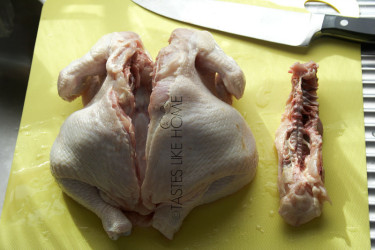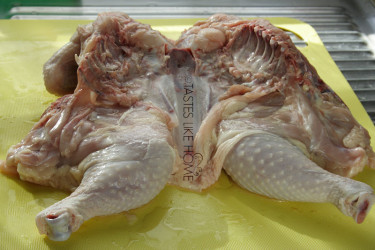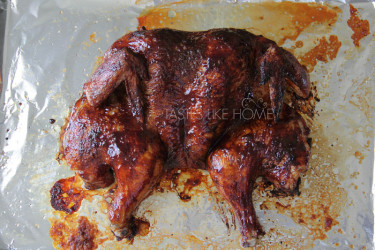While many people will be clamouring for the more prized meats at this time of the year, there are also many who will be looking to an all-time, ‘ordinary’ favourite – the bird, chicken. Actually, it is always a good idea when preparing big meals, and serving more than one meat that chicken should factor in as one of the things to cook. It is easy and there are always picky eaters who would prefer to have something familiar.
 This roast chicken is a little different because we are giving it a combo flavouring – Chinese 5-spice rub and Chinese-style barbeque/dipping sauce – hoisin. The smokiness of the spice rub and the sweet-salt complex caramelization from the sauce is bound to please the palettes of your guests.
This roast chicken is a little different because we are giving it a combo flavouring – Chinese 5-spice rub and Chinese-style barbeque/dipping sauce – hoisin. The smokiness of the spice rub and the sweet-salt complex caramelization from the sauce is bound to please the palettes of your guests.
I know that roasting a whole-chicken can be intimidating that is why I am suggesting that you butterfly the chicken, it will make for easy seasoning, a quicker cook time and it will remove the guess work of wondering if the chicken is done cooking. If you feel that you are not up to the task of removing the spine of the chicken to butterfly it, ask your butcher to do it for you, but honestly, you got this. Look at the photographs for guidance.
Another reason I chose this approach to cooking the chicken is so that when it is time to carve the chicken, especially the breast, you simply flip the chicken over and remove the breast bone so that when you are ready to slice, bones do not hinder you. Like I said, you’ve got this.


SPECIAL EQUIPMENT
1 baking sheet lined with foil or 1 large roasting pan
INGREDIENTS
- 2 teaspoons Chinese 5-spice powder
- 1 ¼ teaspoons fine salt or to taste
- ½ teaspoon ground black pepper
- 1 (4 – 5 pound) whole chicken, butterflied
- 1/3 cup Hoisin sauce
DIRECTIONS

5-spice, Hoisin-glazed Roast Chicken (Photo by Cynthia Nelson) 
5-spice, Hoisin-glazed Roast Chicken (Photo by Cynthia Nelson) Mix together the 5-spice powder, salt and black pepper; set aside.
- Wash and pat dry the chicken. Insert your fingers under the skin of the breast to loosen the skin to make it easy to season the chicken. Your fingers should be able to glide under the skin around the thigh area as well.
- Place the chicken skin-side down and sprinkle with seasoning then using your fingers to massage it into the meat. Turn the chicken over and season under the skin of the breast and thighs. Rub the remaining seasoning all over the skin of the chicken – wings, breast, thighs and legs. Cover and let the chicken marinate at room temperature for 30 minutes. You can do this step the night before, refrigerating the chicken and bringing it up to room temperature before cooking.
- Preheat the oven to 350 degrees F.
- Gently pat the chicken to remove any excess moisture and place in on the lined sheet – skin side up.
- Bake for 1 hour, remove pan with chicken from oven and drain off the drippings (reserve drippings for roasting potatoes or using as stock etc.) Brush all over the top (skin-side) of the chicken with hoisin sauce. Return the pan with the chicken to the oven and cook for 20 minutes or until the juices run clear when you insert a knife in the thigh area by the breast.
- Remove chicken from oven and cover loosely with foil. Let rest for at least 20 minutes before cutting and serving.
Pan-seared Fish Steaks with Sambal
Sambal is a Southeast Asian sauce/condiment made with a variety of peppers – hot and mild – along with other ingredients such as onions, tomatoes, ginger, garlic, shrimp paste, fish sauce, tamarind, lime juice, palm sugar etc. Each country and region has its own particular version of the sauce/condiment as does each household. Sambal is not only used as a condiment but it can also be used as a finishing sauce to flavour cooked meats and especially seafood. When made, it can be stored in an airtight jar in the refrigerator for months.
Make it and use it in this recipe to serve the pescatarians (people who do not eat meat but eat fish) in your gathering. The mashed sweet potatoes are a perfect counterpoint to the spicy fish and accompanying sauce.
The sauce can be made weeks in advance but do not make it the same day you plan to use, give it at least 24 hours for the flavours to meld.
INGREDIENTS

For sambal:
- ¼ cup dried shrimp
- ¾ cup vegetable (or other neutral-tasting oil)
- 2 cups finely minced onions
- 1 cup finely chopped tomatoes
- ½ cup chopped hot pepper (with seeds and membrane)
- ½ cup chopped hot pepper (without seeds and membrane)
- 1 tablespoon finely chopped ginger
- 1 tablespoon tamarind pulp
- 3 tablespoons sugar, or to taste
- Salt to taste
For pan-seared fish:
- 3 pounds firm white fish (snook, grey snapper or similar fish)
- Salt and pepper to taste
- 3 tablespoons oil
- 1 ½ tablespoons unsalted butter
- 3 – 4 tablespoons sambal
- ¾ cup boiling water
- Minced parsley/sliced scallions for garnishing (optional)
DIRECTIONS
For sambal:
- Add shrimp to a bowl and pour hot water to cover the shrimp; soak for 5 minutes only, drain and grind/pound shrimp to a paste. Set aside.
- Add oil to a deep frying pan such as a karahi and place over medium heat. When hot, add onions, reduce heat and let cook until the onions are translucent and soft.
- Add tomatoes, peppers, ginger and shrimp, raise heat to medium and stir to mix. Cook for 3 minutes then reduce heat to low and cook until the peppers and tomatoes are soft and can be mashed with the back of a spoon.
- Add tamarind, sugar and salt to taste, stir and cook for 6 – 8 minutes or until sugar is melted. Taste the sambal and adjust if necessary to suit or taste. Add more salt, sugar or tamarind depending on your taste. If you make adjustments, cook the sauce for another 2 minutes then remove from heat and let cool completely before storing in a sterilized air tight jar/container. Refrigerate.
For pan-seared fish:
- Cut fish into 2-inch thick steaks, rinse and pat very dry.
- Season fish with salt and pepper to taste (remember the sambal also has in salt).
- Add oil to a large shallow frying pan and place over medium heat until the pan is hot but not smoking.
- Add the fish to the pan (work in batches depending on the size of your pan) and let sear for a full 2 minutes before turning. If you try to move the fish and it resists, give it another minute to finish cooking on the one side. Flip the fish and cook it for 1 minute on the other side (the times would vary depending on the thickness of the fish, if it is thinner, then the cooking time would be less).
- Add the butter to the pan to melt and push the fish to one side. Tilt the pan so that the melted butter pools in one area and working quickly, spoon the butter over the fish and then rest the pan back squarely on the stove.
- Add in the sambal along with the boiling water and cook for 1 – 2 minutes. Taste for seasoning and add if necessary. Garnish and serve with mashed sweet potatoes, potatoes, rice, pasta or boiled ground provisions.
NOTE
This same application can work for prawns.









